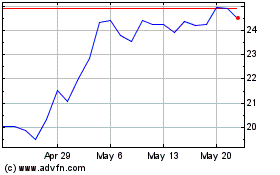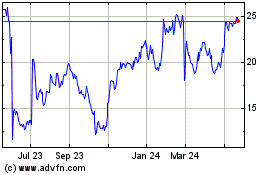Independent Systematic Review and Meta-Analysis Attests to the Significant Risk Stratification Provided by Castle Biosciences’ DecisionDx®-Melanoma Test, Contributing to Personalized Management of Patients with Melanoma
12 December 2024 - 11:00PM
Business Wire
This recently published meta-analysis
encompasses 13 peer-reviewed publications involving thousands of
patients and affirms the powerful risk stratification provided by
DecisionDx-Melanoma and its potential to significantly improve care
for patients with cutaneous melanoma (CM)
Castle Biosciences, Inc. (Nasdaq: CSTL), a company improving
health through innovative tests that guide patient care, today
announced the publication of a new independent meta-analysis in
Cancers assessing the efficacy of its DecisionDx-Melanoma test in
predicting melanoma patient outcomes. The article, titled “The
Prognostic Value of the 31-Gene Expression Profile Test in
Cutaneous Melanoma: A Systematic Review and Meta-Analysis,”
concluded that DecisionDx-Melanoma consistently provides improved
risk stratification over staging alone to inform personalized
management strategies for patients with CM.1
“We believe the clinical performance of our DecisionDx-Melanoma
test is unmatched by other tests currently on the market, both in
its ability to provide precise and clinically meaningful risk
stratification as well as accurate predictions of sentinel lymph
node positivity,” said Matthew Goldberg, M.D., board-certified
dermatologist and dermatopathologist, and senior vice president,
medical, of Castle Biosciences. “This independent publication adds
to the robust body of evidence supporting DecisionDx-Melanoma and
provides a compelling analysis highlighting the broad utility of
the test to improve care for patients with melanoma.”
The authors evaluated peer-reviewed articles that analyzed
DecisionDx-Melanoma risk class data alongside at least one
survival-based metric with a minimum of three years of follow-up.
Systematic reviews, meta-analyses and studies without at least
three years of patient follow-up were excluded. Following these
criteria and additional analyses using Oxford Center guidelines and
the Quality in Prognosis Studies (QUIPS) tool, which assesses six
domains of bias, a total of 13 studies were included in the
meta-analysis.
Across all studies, the DecisionDx-Melanoma test consistently
stratified patients into risk groups with significantly different
outcomes. The five-year melanoma-specific survival rates were:
- 99.8% (95% CI: 98–100%) for patients with a Class 1A/lowest
risk test result,
- 97.6% (95% CI: 92.4–99.3%) for patients with a Class
1B/2A/increased risk test result and
- 83.4% (95% CI: 66.5–92.7%) for patients with a Class 2B/highest
risk test result.
Similar trends were observed for recurrence-free and distant
metastasis-free survival, showing a significant separation of risk
between patients with Class 1A and Class 2B test results.
As summarized by the authors, “the ability to more accurately
stratify patients based on their risk of recurrence and metastasis
has the potential to significantly improve personalized care
strategies, optimizing the balance between treatment efficacy and
quality of life for patients with CM.” The findings provide further
support for use of the DecisionDx-Melanoma test alongside current
staging systems to enhance risk stratification and inform
personalized management strategies for melanoma patients.
About DecisionDx®-Melanoma
DecisionDx-Melanoma is a gene expression profile risk
stratification test. It is designed to inform two clinical
questions in the management of cutaneous melanoma: a patient’s
individual risk of sentinel lymph node positivity and a patient's
personal risk of melanoma recurrence and/or metastasis. By
integrating tumor biology with clinical and pathologic factors
using a validated proprietary algorithm, DecisionDx-Melanoma is
designed to provide a comprehensive and clinically actionable
result to guide risk-aligned patient care. DecisionDx-Melanoma has
been shown to be associated with improved patient survival and has
been studied in more than 10,000 patient samples.
DecisionDx-Melanoma’s clinical value is supported by more than 50
peer-reviewed and published studies, providing confidence in
disease management plans that incorporate the test’s results.
Through Sept. 30, 2024, DecisionDx-Melanoma has been ordered
approximately 183,000 times for patients diagnosed with cutaneous
melanoma. Learn more at www.CastleBiosciences.com.
About Castle Biosciences
Castle Biosciences (Nasdaq: CSTL) is a leading diagnostics
company improving health through innovative tests that guide
patient care. The Company aims to transform disease management by
keeping people first: patients, clinicians, employees and
investors.
Castle’s current portfolio consists of tests for skin cancers,
Barrett’s esophagus, mental health conditions and uveal melanoma.
Additionally, the Company has active research and development
programs for tests in other diseases with high clinical need,
including its test in development to help guide systemic therapy
selection for patients with moderate-to-severe atopic dermatitis,
psoriasis and related conditions. To learn more, please visit
www.CastleBiosciences.com and connect with us on LinkedIn,
Facebook, X and Instagram.
DecisionDx-Melanoma, DecisionDx-CMSeq, i31-SLNB, i31-ROR,
DecisionDx-SCC, MyPath Melanoma, DiffDx-Melanoma, TissueCypher,
IDgenetix, DecisionDx-UM, DecisionDx-PRAME and DecisionDx-UMSeq are
trademarks of Castle Biosciences, Inc.
Forward-Looking Statements
This press release contains forward-looking statements within
the meaning of Section 27A of the Securities Act of 1933, as
amended, and Section 21E of the Securities Exchange Act of 1934, as
amended, which are subject to the “safe harbor” created by those
sections. These forward-looking statements include, but are not
limited to, statements concerning: the ability of the
DecisionDx-Melanoma test to (i) significantly improve care for
patients with CM; (ii) consistently provide improved risk
stratification over staging alone to inform personalized management
strategies for patients with CM; and (iii) provide accurate
predictions of sentinel lymph node positivity. The words “believe,”
“can,” “could,” “potential” and similar expressions are intended to
identify forward-looking statements, although not all
forward-looking statements contain these identifying words. We may
not actually achieve the plans, intentions or expectations
disclosed in our forward-looking statements, and you should not
place undue reliance on our forward-looking statements. Actual
results or events could differ materially from the plans,
intentions and expectations disclosed in the forward-looking
statements that we make. These forward-looking statements involve
risks and uncertainties that could cause our actual results to
differ materially from those in the forward-looking statements,
including, without limitation: subsequent study or trial results
and findings may contradict earlier study or trial results and
findings or may not support the results obtained in these studies,
including with respect to the discussion of our tests in this press
release; actual application of our tests may not provide the
aforementioned benefits to patients; and the risks set forth under
the heading “Risk Factors” in our Annual Report on Form 10-K for
the year ended December 31, 2023, our Quarterly Report on Form 10-Q
for the quarter ended September 30, 2024 and in our other filings
with the SEC. The forward-looking statements are applicable only as
of the date on which they are made, and we do not assume any
obligation to update any forward-looking statements, except as may
be required by law.
1. Durgham RA, Nassar SI, Gun R, et al. The Prognostic Value of
the 31-Gene Expression Profile Test in Cutaneous Melanoma: A
Systematic Review and Meta-Analysis. Cancers. 2024; 16(21):3714.
https://doi.org/10.3390/cancers16213714
View source
version on businesswire.com: https://www.businesswire.com/news/home/20241212538135/en/
Investor Contact: Camilla Zuckero
czuckero@castlebiosciences.com
Media Contact: Allison Marshall
amarshall@castlebiosciences.com
Castle Biosciences (NASDAQ:CSTL)
Historical Stock Chart
From Dec 2024 to Jan 2025

Castle Biosciences (NASDAQ:CSTL)
Historical Stock Chart
From Jan 2024 to Jan 2025
